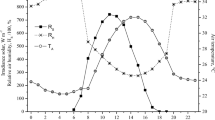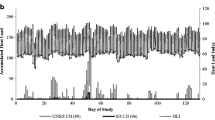Abstract
The amount of short-wave solar radiation willingly tolerated by lactating Holstein cows on pasture was determined in an equatorial semi-arid environment. The study was carried out on a dairy farm located in Limoeiro do Norte, CE, northeastern Brazil. The observed behaviours were as follows: grazing, under the sun, under the shade, standing, lying, ruminating, idling and wallowing in the water. The behaviours were recorded using instantaneous scan sampling at regular intervals of 15 min from 0600 to 1800 hours over 5 days. On all sampling days, the meteorological variables, including local short-wave solar radiation (R S-W, W m−2), were recorded. The R S-W data were divided into five levels. The sun exposure was more frequent under low (100 %) and moderately low (97 %) levels, when R S-W remained below 500 W m−2. The grazing was more intense under low (100 %) and moderately low (93 %) levels. Above 500 W m−2, the grazing time significantly decreased (11 %). The cows avoided grazing under high (0 %) and very high (0 %) levels, when R S-W exceeded 700 W m−2. The ruminating behaviour was more frequent under high (33 %) and very high (37 %) levels, in which the highest averages of R S-W were recorded (815 and 958 W m−2, respectively). The standing posture was more frequent under low (100 %) and moderately low (97 %) levels. Therefore, the critical R S-W level that motivates cows to stop grazing and seek shade was in the interval between 500 and 700 W m−2.

Similar content being viewed by others
References
Berman, A. and Horovitz, T., 2012. Radiant heat loss, an unexploited path for heat stress reduction in shaded cattle, Journal of Dairy Science, 95, 3021–3031
Da Silva, R.G., Guilhermino, M.M. and De Morais, D.A.E.F., 2010. Thermal radiation absorbed by dairy cows in pasture, International Journal of Biometeorology, 54, 5–11
Da Silva, R.G., Maia, A.S.C., Costa, L.L.M. and Queiroz, J.P.A.F., 2012. Latent heat loss of dairy cows in an equatorial semi-arid environment, International Journal of Biometeorology, 56, 927–932
Dikmen, S., 2013. The effect of breed in a hot environment on some welfare indicators in feedlot cattle, Spanish Journal of Agricultural Research, 11, 1028–1035
Domingos, H.G.T., Maia, A.S.C., Souza Jr., J.B.F., Silva, R.B., Vieira, F.M.C. and Silva, R.G., 2013. Effect of shade and water sprinkling on physiological responses and milk yields of Holstein cows in a semi-arid region, Livestock Science, 154, 169–174
Khongdee, T., Sripoon, S. and Vajrabukka, C., 2011. The effects of high temperature and wallow on physiological responses of swamp buffaloes (Bubalus bubalis) during winter season in Thailand, Journal of Thermal Biology, 36, 417–421
Marai, I.F.M. and Haeeb, A.A.M., 2010. Buffalo’s biological functions as affected by heat stress—A review, Livestock Science, 127, 89–109
Martin, P. and Bateson, P., 2007. Measuring Behaviour: An Introductory Guide, (Cambridge University Press, Cambridge)
Moallem, U., Altmark, G., Lehrer, H. and Arieli, A., 2010. Performance of high-yielding dairy cows supplemented with fat or concentrate under hot and humid climates, Journal of Dairy Science, 93, 3192–3202
O’Brien, M.D., Rhoads, R.P., Sanders, S.R., Duff, G.C. and Baumgard, L.H., 2010. Metabolic adaptations to heat stress in growing cattle, Domestic Animal Endocrinology, 38, 86–94
SAS Institute, 1995. User’s Guide: Statistics, (SAS Institute Inc., Cary)
Schütz, K.E., Cox, N.R. and Matthews, L.R., 2008. How important is shade to dairy cattle? Choice between shade or lying following different levels of lying deprivation, Applied Animal Behaviour Science, 114, 307–318
Schütz, K.E., Rogers, A.R., Cox, N.R. and Tucker, C.B., 2009. Dairy cows prefer shade that offers greater protection against solar radiation in summer: Shade use, behaviour, and body temperature, Applied Animal Behaviour Science, 116, 28–34.
Schütz, K.E., Rogers, A.R., Poulouin, Y.A., Cox, N.R. and Tucker, C.B., 2010. The amount of shade influences the behavior and physiology of dairy cattle, Journal of Dairy Science, 93, 125–133
Schütz, K.E., Rogers, A.R., Cox, N.R., Webster, J.R. and Tucker, C.B., 2011. Dairy cattle prefer shade over sprinklers: Effects on behavior and physiology, Journal of Dairy Science, 94, 273–283
Soriani, N., Panella, G. and Calamari, L., 2013. Rumination time during the summer season and its relationships with metabolic conditions and milk production, Journal of Dairy Science, 96, 5082–5094
Van laer, E., Moons, C.P.H., Sonck, B. and Tuyttens, F.A.M., 2014. Importance of outdoor shelter for cattle in temperate climates, Livestock Science, 159, 87–101
Vermunt, J.J. and Tranter, B.P., 2011. Heat stress in dairy cattle—a review, and some of the potential risks associated with the nutritional management of this condition. In: review of AVA QLD Division Conference, 2010, (Australian Veterinary Association), 212–221
Acknowledgments
The present study was supported by a grant from the Conselho Nacional de Desenvolvimento Científico e Tecnológico (CNPq), number 481084/2008 and number 503736/2009-0. We thank Mr. Caxeado for making this study possible by generously allowing access to his farm and Ivana and her family for all their support given to our team at data collection.
Conflict of interest
The authors declare that they have no conflict of interest.
Author information
Authors and Affiliations
Corresponding author
Rights and permissions
About this article
Cite this article
Oliveira, S.E.O., Costa, C.C.d.M., de Souza, J.B.F. et al. Short-wave solar radiation level willingly tolerated by lactating Holstein cows in an equatorial semi-arid environment. Trop Anim Health Prod 46, 1413–1417 (2014). https://doi.org/10.1007/s11250-014-0657-7
Received:
Accepted:
Published:
Issue Date:
DOI: https://doi.org/10.1007/s11250-014-0657-7




